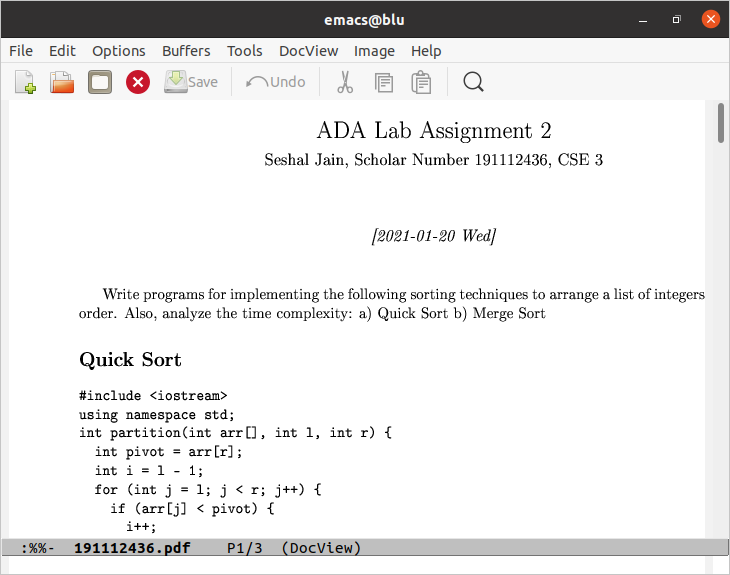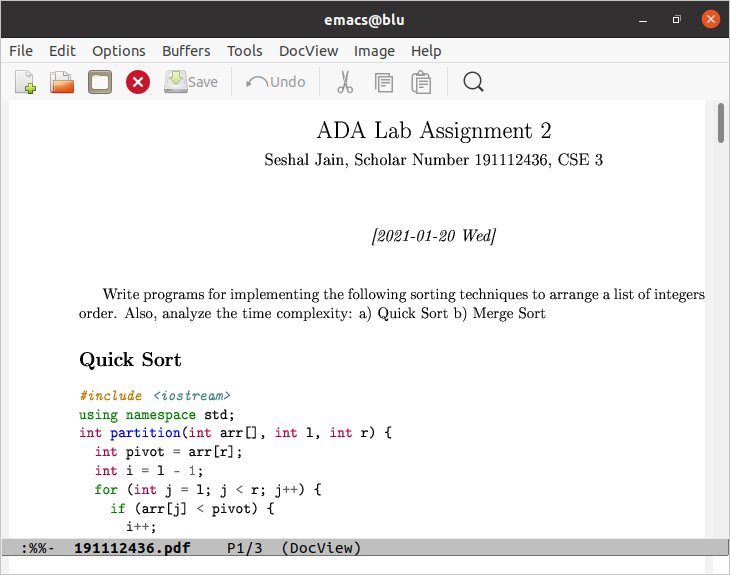January 23, 2021 · 6 min read
In the 3rd Semester of my Bachelor of Technology in Computer Science course at MANIT, Bhopal, I came across Emacs. I won’t be lying when I say it changed my life.
I use Emacs for all my text-based work (more posts on this coming
soon!), and it naturally made sense for me to experiment with it for my
programming lab assignments.
The general workflow of the labs I am currently enrolled in is something
like this:
- Professor assigns some task, ex. Analysis of Various Sorting Algorithms
- The student writes relevant code/explanation for the given program
- The student runs the program in a console, takes screenshots, and prepares a document in Word/Docs
- The student mails a generated PDF (or even the original file) to the professor
I realised in the first few weeks that this is a very cumbersome
process, since we’re dealing with images and syntax highlighting.
It does not make any sense to paste code from an IDE into a word
processor, where it loses the syntax highlighting or worse, is typeset
into an unreadable sans-serif typeface (Calibri, I’m looking at you)
😩.
I was exploring Org Mode around the same time,
and it is the perfect tool for this use case.
I now use literate programming to write and run source code in the same
file as my explanation, and it is then exported to LaTeX natively by Org
to general beautiful, publication-ready PDFs. Additionally, since all of
it is in plain text, I also host my assignments in version control on
Github, where Org
files are rendered like regular pages. Awesome 🔥!
I have a fully custom Emacs config, you are welcome to check it out on Github. However, you do not need the entire configuration, the tools should work natively with Emacs too!
Emacs Setup
On Ubuntu, installing Emacs is as simple as
sudo apt install emacs
This should install Emacs 26.3 as of writing. Go on, launch your Emacs!

TeX Setup
I use TinyTeX because of its small
footprint, but essentially all you need is a TeX processor.
You can find the install instructions on its website:
wget -qO- "https://yihui.org/tinytex/install-bin-unix.sh" | sh
This will install tlmgr and other TeX binaries on your system.
Note: You might need to log out and log in again for the binaries to
be accessible on your PATH.
Org
Org files are saved with a .org extension. Org is extremely powerful,
with robust support for text formatting and source code blocks. This is
extremely helpful, especially for us as you will see.
All Org mode headings start with *, with the number of * indicating the
depth.
You can add text as is, somewhat like Markdown. Check out all of Org
Mode’s features in the Org Mode Manual.
Now here’s the interesting part. You can write source code inline within Org’s source blocks, with complete support for syntax highlighting, code building and auto-completion. 😲
For starters, you can use my
ADA
Lab 2 Assignment file.
After opening it in Emacs, you will see that the code blocks are already
being highlighted using C++ syntax. To edit the code, place the cursor
somewhere inside the code block and press C-c ‘.
This will launch a C++ buffer where you can edit the file with C++
language support. Press C-c ’ to confirm the changes or C-c C-k to
cancel.
As you may have noticed by now, Emacs is very keyboard intensive, you
will learn the keybindings with practice over time.
You can also search for commands via M-x because almost everything in
Emacs is a (searchable) function.
Let’s export this Org file now.
In the main Org file, enter C-c C-e to launch the Org Export window.
There are a myriad of options available, feel free to play around! I
especially like the UTF-8 export when submitting assignments in
plaintext. Adds additional flair to your work 😉.
Oh! By the way, press C-g almost anywhere in Emacs to cancel the current operation.
To export the file to PDF via TeX, enter C-c C-e l p. This creates a TeX
file from your Org file and uses LaTeX to convert it to a PDF.
…but wait! There seems to be an error! To open the error log, enter
C-x C-b and select the buffer named * Org PDF LaTeX Output *.
You will find a line stating the name of the missing package:
! LaTeX Error: File `<packagename>.sty' not found.
This is because TinyTeX is very minimal, it comes only with the bare
minimum packages pre-installed. tlmgr allows you to install all the
TeX packages you need from the CTAN repository. When it shows an error,
run the following command to install the relevant package:
tlmgr install <packagename>
Once you install all the missing packages, you should see a .tex and a
.pdf file on the same directory. Open up your very first Org-powered
PDF!
Protip: You can open PDFs in Emacs too! Simple use C-x C-f on a PDF
file.

This is pretty awesome, but you can do even better! Minted adds syntax
highlighting functionality to the SRC blocks on LaTeX export.
Minted
Minted is a LaTeX package which uses Python’s
Pygments library to generate syntax
highlighted code output. This is an external dependecy and also requires
some Emacs configuration.
Install Pygments via pip:
pip install Pygments
Note: The pygmentize binary must be accessible on your PATH after
installation.
Install minted via tlmgr:
tlmgr install minted
We have installed the external dependencies, now we need to configure Emacs to use these.
Navigate to the * scratch * buffer. Switch to Org mode using M-x org-mode [RET].
Create a Org source block by entering <s [TAB] and add emacs-lisp as
the language.
The block should now look like this:
#+BEGIN_SRC emacs-lisp
#+END_SRC
In this source block, add the following code:
(setq org-latex-listings 'minted
org-latex-packages-alist '(("" "minted"))
org-latex-pdf-process
'("pdflatex -shell-escape -interaction nonstopmode -output-directory %o %f"
"pdflatex -shell-escape -interaction nonstopmode -output-directory %o %f"
"pdflatex -shell-escape -interaction nonstopmode -output-directory %o %f"))
You can execute this code, right here, in this file by using C-c C-c. This will enable these features for your current session.
To make these changes permanent, open the ~/.emacs.d/init.el file
(create one if it does not exist) and add the Lisp code there. init.el
is a special file which is launched at Emacs startup.
Congratulations, you now have a build process to generate beautiful assignments via LaTeX!

tl;dr
- Org Mode in Emacs supports LaTeX export natively, but requires the TeX binaries to be installed and accessible on PATH
- The
mintedpackage usesPygmentsto add syntax highlighting to LaTeX exports - Emacs can render PDFs natively
Feel free to reach out to me via Twitter for any questions/suggestions! 😁